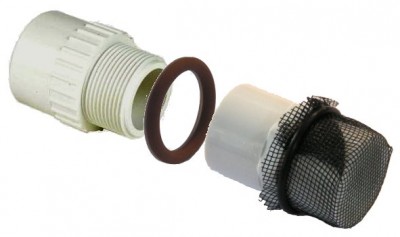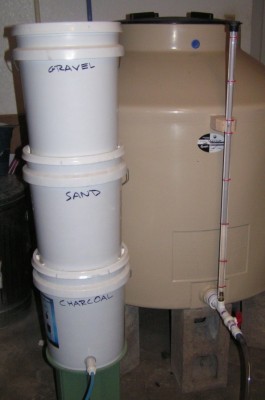How To Build A Water Filter For A Spring
Everyone who talks virtually survival eventually talks about water filtration. You see all kinds of reviews on this water filter and that—whichever is the favorite of the person doing the writing. Withal, well-nigh all of them have one declining in mutual; the filter element eventually has to be replaced. While there are a few filters on the marketplace that are backflushable to make clean them out, there are simply a few.
Of course, if there's a general breakdown in society, for whatever reason, availability to filters or filter cartridges will be substantially cut off. That ways that whenever your filter supply runs out, you're going to exist left with a huge problem. Since the water probably won't be safe to drink, y'all'll take to boil or distill enough for your needs, a slow procedure.
The biggest risk in drinking most h2o is that of waterborne pathogens. Bacteria, protozoa, and other microscopic parasites can be found in almost whatever water supply, some of which can kill you, and many of which can make you wish you were dead.
The other problem that yous might end up facing is chemicals in the h2o. Basically, filtering systems ignore this problem, concentrating on dealing with the much more common problem of those pathogens. Most the only effective means of dealing with chemicals is by neutralizing them or past distillation. Even with distillation, it is possible to end up with some chemicals in the h2o, if the chemicals' vapor point is lower than that of water.
Bio-filters, a Great Culling
Another option, instead of buying expensive commercial filters and stockpiling them, is to build a bio-filter. This elementary filtering organisation is used worldwide to purify h2o for drinking. While it may not go out every pathogen in the water, it will get out enough that yous can safely beverage the water, assuasive your body to destroy the few that manage to become through the filter.
Actually, a bio-filter works almost the same mode that a sewage treatment plant does. The standard for h2o treatment plants is that the water that leaves it must be clean enough to beverage. To accomplish that, they use a multi-phase approach to removing anything harmful from the water. Likewise, a bio-filter uses a multi-stage approach to removing impurities and pathogens from the h2o, so that the water that remains is drink. The only difference is that you can make it yourself.
Bio-filters have three divide layers:
- Gravel
- Sand
- Activated charcoal
Each of these layers removes unlike things, leaving the water that comes out of them clean enough to drink safely, fifty-fifty if you got that water from an ugly looking pond near your home.
The first layer, gravel, is there to remove large pieces of debris from the water. This would include things like pocket-size sticks, leaves, the odd tadpole and bugs. The water then moves on to the sand layer, which removes smaller particulate matter that managed to pass through the gravel. Finally, the water passes through a layer of activated charcoal to remove bacteria and some chemicals.
Ultra Efficient H2o Filter Fits In Your Pocket!
Information technology is the activated charcoal that is the surreptitious to a bio-filter'due south success. Activated charcoal or activated carbon (the aforementioned thing) is "activated" by blowing air through information technology. That air causes thousands of pores to open up on the surface of the charcoal, making convenient places for assimilation of chemicals via bonding and capture of bacteria. The microporosity of activated carbon means that just one gram of information technology has over 500 mtwo of surface surface area. That huge surface area is what makes it so effective.
Edifice the Bio-Filter
To build a bio-filter, all you need are the three ingredients mentioned to a higher place, along with some food grade five gallon buckets. You'll also need some screen, a few plastic plumbing fittings and a hole saw.
There are several ways of going about this, but the manner I like to do information technology is past using plumbing fittings between the stages of the filter. By using a fitting, you can take ameliorate command over the water flow and aid make sure that the materials don't drift from one bucket to the next.

To assemble your fittings and build your filter, do the following:
- The fitting that is going to get on the inside of the bucket needs to have fiberglass screen stretched over it. That tin be held in place with a rubber band or O-ring. However, gluing it makes it more secure.
- Cut a hole in the bottom eye of two buckets, which is the right diameter for the threaded part of the fitting to become through. Cut the aforementioned size hole in the side of the third bucket, which is just above the bottom.
- Attach the fittings together, with the lesser or side of the bucket between them. The screened side of the fittings should be upward. Use an O-ring betwixt the fittings to create a seal.
- For the bottom bucket, the one that has the fitting through the side, yous may desire to add a valve, an angled fitting or a fitting with a flexible tube for the outlet. Whichever you choose should let you lot to have the filtered water go into a fourth saucepan, pitcher or other container.
- Cut a hole in the center of the lids for two of the buckets, which is slightly larger than the fitting. You don't need a tight fit here, rather one that will make it easy to stack your buckets.
- To protect the screen from the weight of the sand and gravel, put a cover over information technology. The easiest way to make this cover is with some pocket-sized plastic cups. Drill a number of holes in the sides of the cups, so that the water can get through. And so gum the cup upside-downwards over the fitting.
- Before putting your gravel, sand and activated charcoal in the filter, it needs to be rinsed thoroughly to remove all dirt and silt. When y'all can put on these materials, without any grit fogging the water, then it is rinsed thoroughly enough.
- You will need to fill each bucket 2/3 to 3/4 full of the filter materials. The activated charcoal goes in the bottom bucket, which should exist the one with the fitting on the side. Put one of the lids with the hole in it on this bucket. Set the bucket for the sand on peak of it, and the bucket for the gravel on tiptop. The height saucepan's lid does not need any hole in information technology. A plain lid tin be used to go along whatever droppings from falling into this bucket.
The finished filter will be able to process quite a few gallons of purified water per day. For the best possible water, you lot'll need to aerate information technology after filtration. Aeration is a simple process, which adds air to the water. Yous can accomplish this by pouring the water back and forth a few times betwixt a couple of buckets or pitchers.

Finished bio-filter, shown by a 750 liter (200 gallon) storage tank. The plastic tube on the forepart of the tank shows the current h2o level as existence about ane/3 full.

How To Build A Water Filter For A Spring,
Source: https://www.offthegridnews.com/how-to-2/how-to-build-a-bio-water-filter/
Posted by: ouelletteoncely.blogspot.com



0 Response to "How To Build A Water Filter For A Spring"
Post a Comment